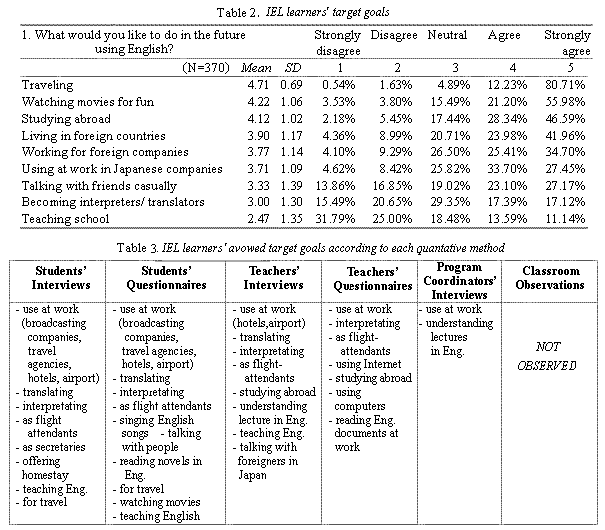May 22-23, 2004. Tokyo, Japan: Tokyo Keizai University.
Triangulating perceptions of learners' needs:
|
|
Abstract Keywords: needs analysis, data triangulation, program evaluation, survey design
|
Triangulating perceptions of learners' needs:
|
|
Abstract Keywords: needs analysis, data triangulation, program evaluation, survey design
|
| ". . . needs analysis should be a logical first step in curriculum development." |
[ p. 33 ]

Issues regarding multiple methods and sources
| ". . . needs analysis research should be carefully designed to include multiple data sources and methods." |
We do recommend that you use more than one data source or method and that you balance quantitative methods with qualitative ones. Data from any single method (surveys, interviews, focus groups, or analysis of existing records) are generally insufficient to provide an adequate basis for understanding needs and making decisions on priorities
An example using this approach
[ p. 34 ]
1. TARGET TASKS: What kinds of things would you like to do in the future using English? 2. PROBLEMS: What kinds of things would you have difficulty with in listening? 3. PRIORITIES: What kinds of things would you prefer to listen to in the IE listening class? 4. ABILITIES: What kinds of things can you do using English now? 5. ATTITUDES: What do you like about and do not like about your IE listening class? 6. PROBLEMS: Do you have any complaints of problems in the IE listening class? 7. SOLUTIONS: Do you feel that your IE listening class helps you to be a better listener? If not, do you have any ideas about certain things that need to be changed in IE listening program?
[ p. 35 ]

In my way of thinking, there is a gap between students' wishes and reality. Most of the students want to work for international divisions in American companies, and negotiate with foreigners. That's all that they can imagine. In my opinion, as long as they work for companies in Japan, it will not matter if they are good at English or not. A small number of people can use English as teachers. That's another possibility: there are a very small number of people who apply their English skills at work. So the only chances they have to use English are if they become teachers or flight attendants. However, in my days, and these days as well, there are fewer and fewer chances to be flight attendants. You know, few people use English at work. I think that only returnees who have lived abroad for five or ten years are going to get the work that requires English. When I look around, I am the only one who uses English at work.
[ p. 36 ]
. . . you never know what's going to happen in the future. Things may change. You may all of a sudden be in a position where you need English. So just because you don't need it immediately doesn't mean you won't need it in the future.In other words, situations may arise in which English becomes suddenly necessary.
Conclusion
| ". . . it is important to involve all participants in the educational process and develop a program based on broad consensus rather than top-down management ultimatums." |
References